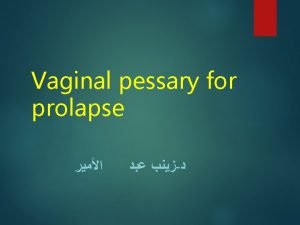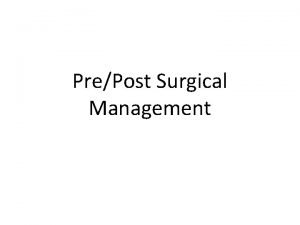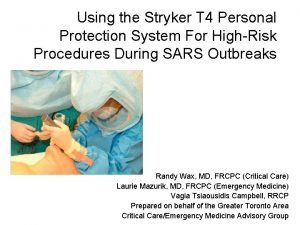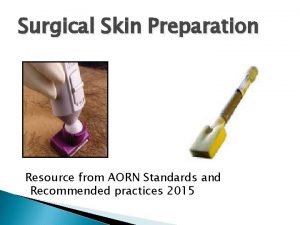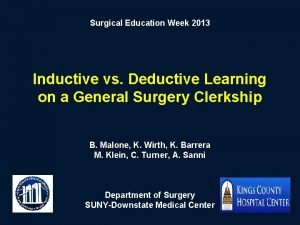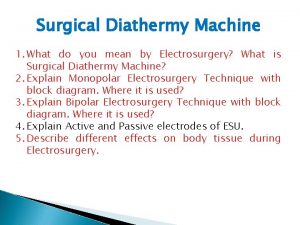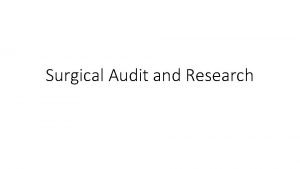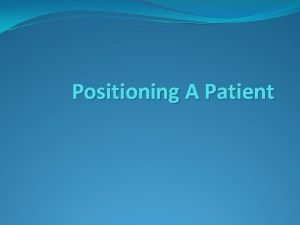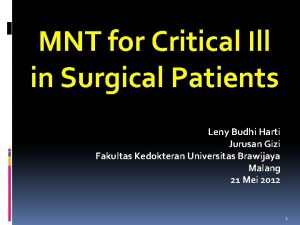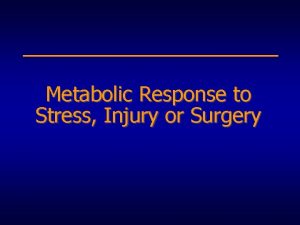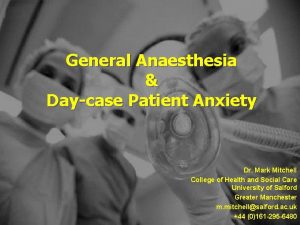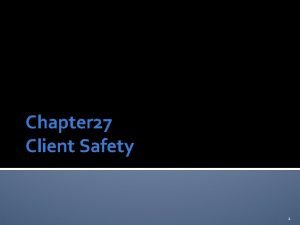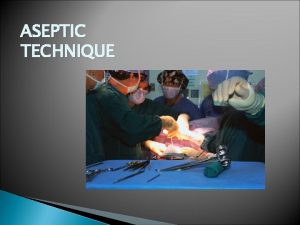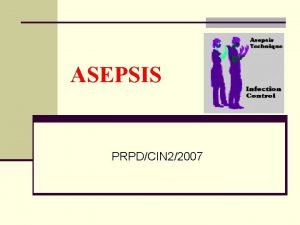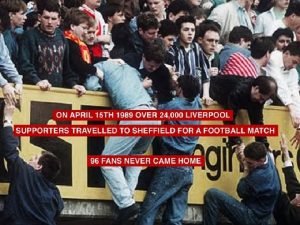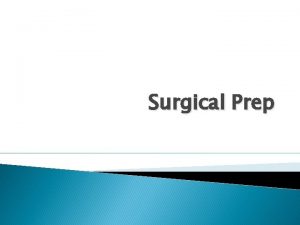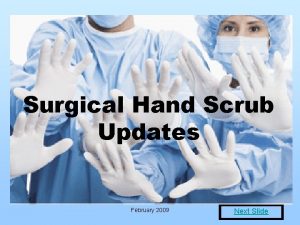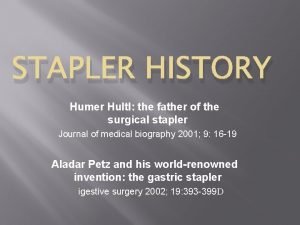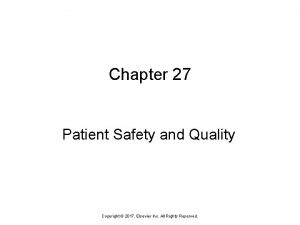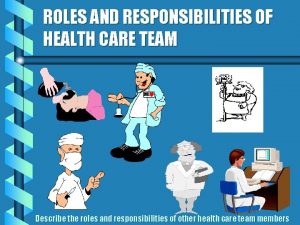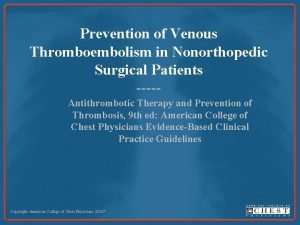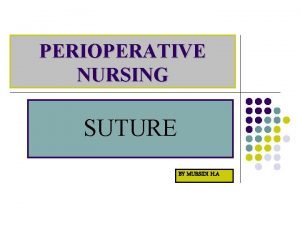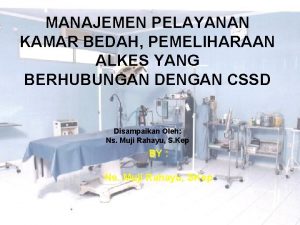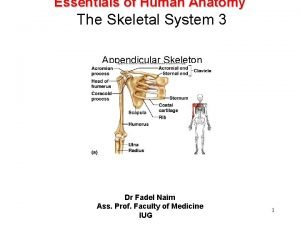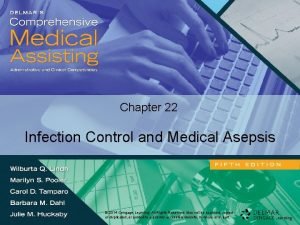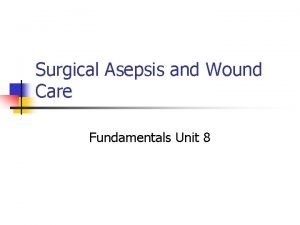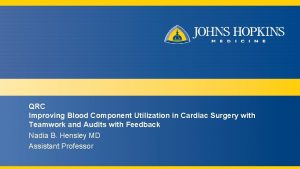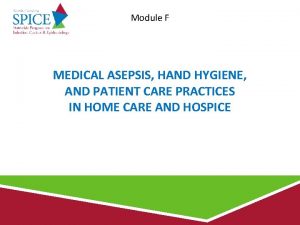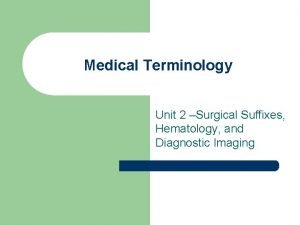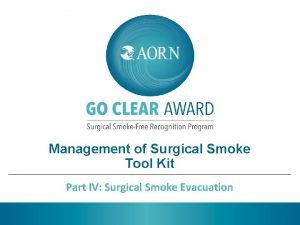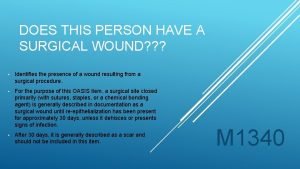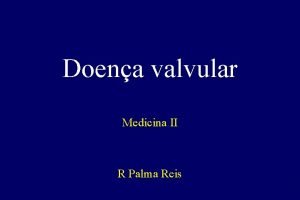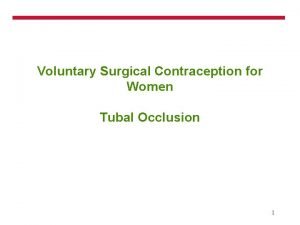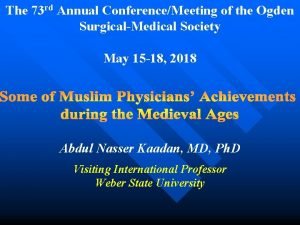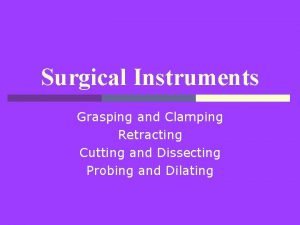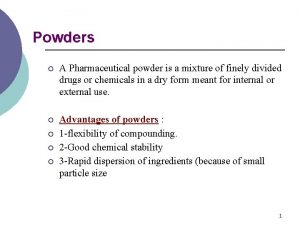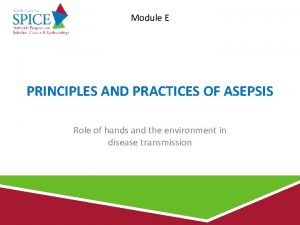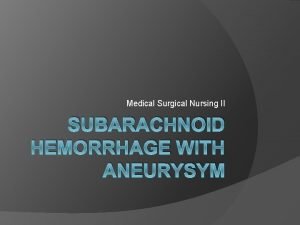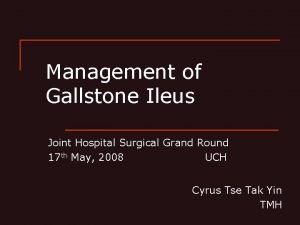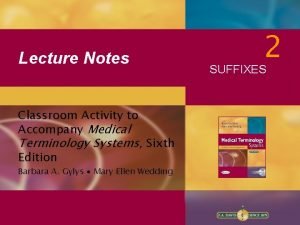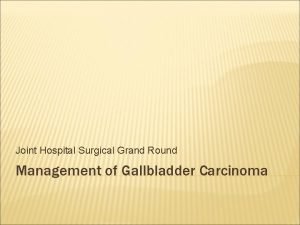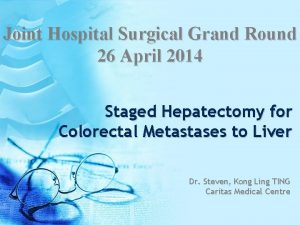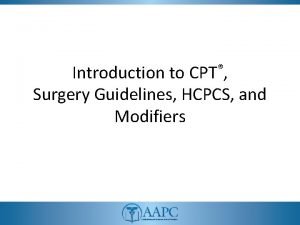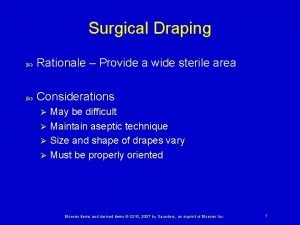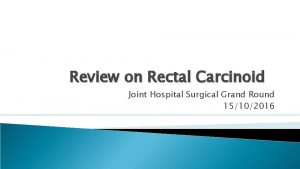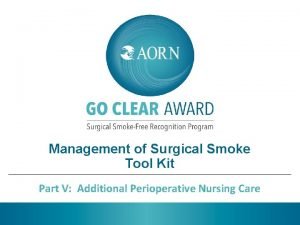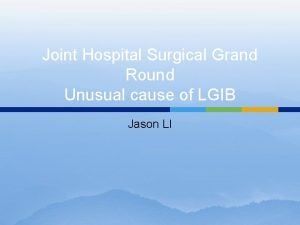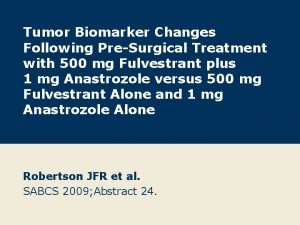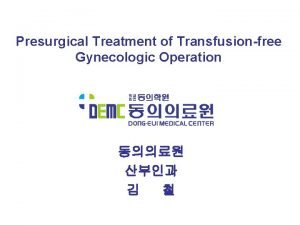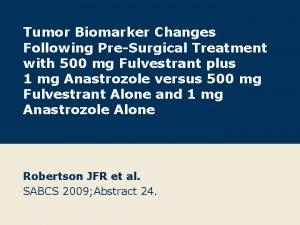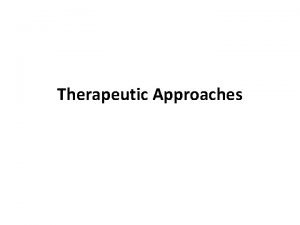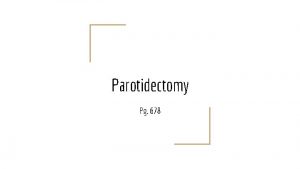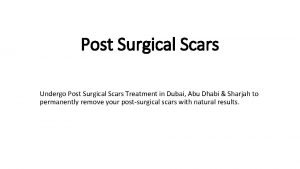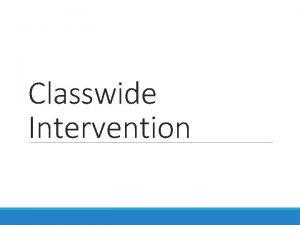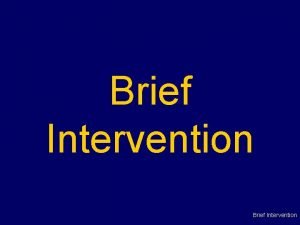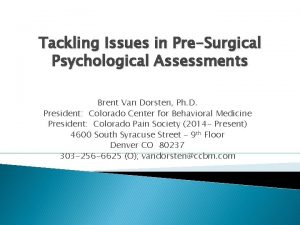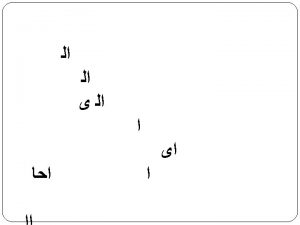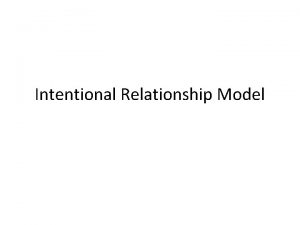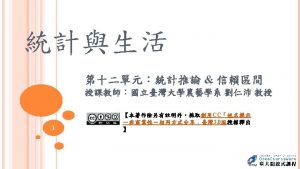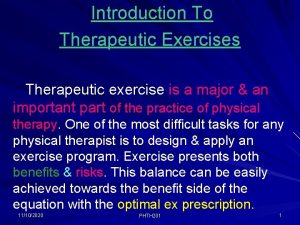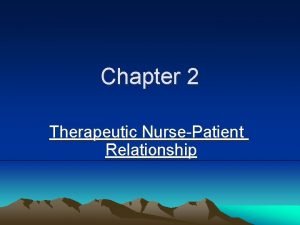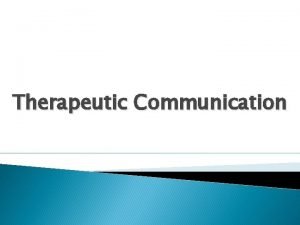PrePost Surgical Management PreSurgical Intervention Therapeutic Management Treatment






























































- Slides: 62

Pre/Post Surgical Management

Pre-Surgical Intervention Therapeutic Management

Treatment Goals • FAMILY EDUCATION: Top Priority including traditional treatment: ROM, scapula and gleno-humeral stabilization • PRECAUTIONS/PLANS: Positioning/Handling ADLs: feeding, dressing, batheing Diagnostic work-up, specialists

Treatment Goals • Maintain PROM/ minimize axillary contractures • Obtain AROM • Preserve joint integrity • Promote age appropriate developmental skills acquisition

Treatment Goals • Promote sensory awareness of affected UE • Promote visual awareness of affected UE (midline) • Prevent/minimize compensatory patterns of movement • Monitor potential associated problems: medial rotation posture/deformity related to muscle imbalances

Treatment-Positioning Infants: No longer pinning arm to chest unless fracture present Position in 90 degrees of external rotation and horizontal abduction Older infants (4 month +) Supine and Prone Shoulder abducted to 90 degrees with external rotation



Tummy Time

Treatment- PROM • Should be performed through full range as expected for developmental age with careful concentration paid to shoulder flexion/abduction/external rotation. • Should always support normal scapulo-humeral rhythm • Please be aware of possible humeral/radial dislocation • If clavicular fracture present, avoid PROM until cleared by the physician


Treatment-AROM • Early facilitation of AROM is critical for the prevention of learned nonuse General Guidelines • Start in gravity eliminated or gravity assisted position • Reflexes can be helpful to elicit muscle contraction • Weakness can develop in muscles not directly affected by the lesion


Treatment-AROM • Facilitation of shoulder stability is the basis for controlled arm and hand function • Weight bearing and weight shift in prone with adequate stability. Not done if unstable shoulder • Assisted reach while in prone


Facilitation of ER Gentle stretch to pectorals is essential MFR, strain/counterstrain Gentle joint mobilization Massage Trunk rotation while weight-bearing on fixed affected UE • Reaching out to side with humerus fixed against trunk • • •


Facilitation of Reach • Stabilizing and mobilizing scapula • Humeral guidance while facilitating humeral flexion and ER (inhibit excessive humeral abduction) • Gentle humeral compression during reach • Facilitate reach without grasp, but reach to touch easier


Facilitation of Supination • Shoulder should be in a neutral position first • Gentle humeral compression during reach • Cylindrically shaped toys presented in vertical fashion • Present toys to radial side of hand

Facilitation of Supination • Treatment Strategies Encourage hand to mouth and toy to mouth play Finger feeding Bimanual holding of toys Banging blocks Holding bottle at feeds Stickers on palmer surface or wrist Weight shifting while in prone



Facilitation of Grasp • Treatment Strategies Toy to mouth Traction and propioceptive input through palm Weight bearing through palm/correction of weight bearing through dorsal surface Hold large object requiring two hands Use velcro strap on hand to maintain hold


Treatment- Sensory Stimulation Exploring other body parts Provide infant massage over affected extremity Provide vibratory input Provide joint compression Provide variety of textures Alter temperature of toys


Treatment-Visual Input Affected extremity should always be in visual field to reduce the chances of developmental apraxia Place bell on small wrist band to encourage child to look at arm when spontaneous movement occurs



Treatment- Developmental Sequence General points of consideration Utilize age appropriate activities Keep it fun through variety of stimulation Insure successful experience Watch entire body for compensations


Treatment/NMES

Treatment: Constraint-Induced Therapy Constraint-Induced Video. mpg

Treatment-Splinting Goals: Protect joint Prevent contractures Promote increased function Deficits determine splinting needs Not all infants need splinting.






Post-Surgical Interventions Therapy Intervention Following Mod Quad Procedure



Post-Surgical Rehab/Mod Quad • Statue of Liberty (SOL) splint is removed by OT on post-op day #1 to assess current shoulder AROM • AROM tested anti-gravity & gravity eliminated planes • Based on AROM findings decision on splint wearing time is made • AROM might be restricted by pain and dressings • Typically infants sleep with SOL for 3 weeks

Post-Surgical Rehab/Mod Quad • Typically infants under 12 -18 months do not need splinting during day-time Splinting at night time only for 3 weeks • • Children 2 + more aware of pain and discomfort Might need splinting 18/7 for 1 -3 weeks Splint is to promote healing and for pain control Important to remove splint 1 -2 hours at least 2 x day

Post-Surgical Rehab/Mod Quad AROM/AAROM begin immediately Infant’s and younger children restrict AROM on non-affected extremity (elbow splint) Children 12+: pillow splint with shoulder at 80/90 degree angle to prevent numbness/tingling Protocol for older children varies. Generally AAROM/AROM begins at post-op day #1 and performed every hour Compensatory patterns big problem for older children

Post Surgical Rehab/Mod Quad • Formal therapy typically resumes at post-op weeks 2 -3 • Encourage active movement and function through play and participation in self-care skills • Non-resistive activities: balloons, bubbles, magnets • Do not encourage medial rotation or adduction at the shoulder

Post-Surgical Rehab/Mod Quad • Post-op weeks: 0 -3: PROM/AAROM/AROM To shoulder flexion/abduction/external rotation • Post-op weeks: 3 -6: Therapy might resume Continue AROM/AAROM Aquatics might begin Discourage compensatory patterns of movement

Post-Surgical Rehab/Mod Quad • Post-op weeks 6 and after Discontinue night time splint Scar massage/silicone gels Assessment of the scapular stabilizers on both sides must be done prior to begin progressive strengthening Consider kinesio-taping, theratogs, special braces to build and maintain scapular stability TES/other modalities could be started

Post-Surgical Rehab/Mod Quad • Special Considerations – Children with shear deformity will continue to exhibit shoulder AROM deficits – CT scan is ordered at post op week 3 to 6 to assess shear deformity and plan for Triangle Tilt surgery – TT surgery is typically planned 3 -6 months following MQ

Post-Surgical Interventions Therapy Intervention Following Triangle Tilt Procedure


Post-Surgical Rehab/Triangle Tilt • OT perform splint check and family education on TT protocol and post-op day #1 • Saro brace: worn 24/7 without removal for 3 to 6 weeks This will be pending on severity of shear deformity • Saro position goal: elbow crease forward with thumb up • Clear plastic of splint from axillary area • Splint should be sitting above hip joint unless child is female with breast development


Post-Surgical Rehab/Triangle Tilt Post-op dressings are removed by pediatrician at post-op week #1 Elbow PROM begins at post-op day #2 to prevent elbow stiffness and biceps spasms Saro brace is removed at post-op week 3 to 6 at home or therapy clinic Heat modalities recommended: hot pack or bath Expect loss of ROM at shoulder No Saro brace at night until functional AROM at shoulder re-gained

Position of SARO Brace on a Female Teenager

Post-Surgical Rehab/Triangle Tilt • Send follow up video to Dr. Nath • Weeks 3 -6 to 8: Full PROM and AROM as tolerated – Therapy resumes at post-op weeks 3 -6 (when saro brace is not longer used) • Early therapy goals: Increase AROM to shoulder flexion/abduction and elbow flexion


Post-Surgical Rehab/Triangle Tilt • Weeks 8 to 12: – Continue with progressive AROM activities – Constraint-induced therapy is recommended with attention paid to maintaining alignment • All compensatory movements to be discouraged such as hiking the hip, rotating or bending body backward • Serial casting at the elbow might be started if elbow flexion contracture present (refer to casting protocol)

Serial Casting: Before/After

Post-Surgical Rehab/Triangle Tilt Weeks 12+: Begin strengthening program Weight bearing as tolerated Assess: alignment of the scapula on the rib cage Alignment and mobility of the gleno-humeral joint AROM/PROM and strength Treatment focus initially on strengthening of the scapular stabilizers to promote scapulo-humeral rhythm

Post-Surgical Rehab/Triangle Tilt • Therapy after TT protocol generally begins with a frequency of 2 x per week but should be modified on a case by case basis Therapy is recommended for at least 6 months following TT surgery The following modalities are also recommended TES/Bio-feedback, kinesio-taping, bracing etc.
 Vaginal pessary
Vaginal pessary Intervention treatment
Intervention treatment Change management interventions
Change management interventions Amerigel post op surgical kit
Amerigel post op surgical kit Stryker surgical helmet
Stryker surgical helmet Surgical sieve vitamin
Surgical sieve vitamin Sterile gloves
Sterile gloves Inductive vs deductive learning
Inductive vs deductive learning Diathermy machine
Diathermy machine Surgical audit examples
Surgical audit examples Horizontal recumbent or supine position
Horizontal recumbent or supine position Mnt critically ill
Mnt critically ill Surgical metabolism
Surgical metabolism Surgical planning laboratory
Surgical planning laboratory Surgical metabolism
Surgical metabolism Conclusion of medical surgical nursing
Conclusion of medical surgical nursing A newly admitted patient was found wandering
A newly admitted patient was found wandering Aseptic technique clipart
Aseptic technique clipart Medical vs surgical aseptic hand washing
Medical vs surgical aseptic hand washing Acute specific surgical infection
Acute specific surgical infection Care of the critically ill surgical patient
Care of the critically ill surgical patient Surgical prep
Surgical prep Avagard surgical scrub instructions
Avagard surgical scrub instructions Hultl
Hultl A nurse floats to a busy surgical unit
A nurse floats to a busy surgical unit Roles and responsibilities of healthcare team
Roles and responsibilities of healthcare team Prevention of vte in nonorthopedic surgical patients
Prevention of vte in nonorthopedic surgical patients Surgical needle holder specialty polymers
Surgical needle holder specialty polymers Maintenance of surgical instruments
Maintenance of surgical instruments Surgical neck
Surgical neck Chapter 22 surgical asepsis
Chapter 22 surgical asepsis Surgical neck
Surgical neck Wellspan inet
Wellspan inet Surgical suffixes examples
Surgical suffixes examples Aorn surgical hand scrub
Aorn surgical hand scrub Surgical bandage types
Surgical bandage types Abdominal surgical scars
Abdominal surgical scars Qrc surgical
Qrc surgical Medical asepsis definition
Medical asepsis definition Rdcs medical abbreviation
Rdcs medical abbreviation Surgical plume evacuator tool
Surgical plume evacuator tool Surgical bandage types
Surgical bandage types Picc line surgical wound oasis
Picc line surgical wound oasis Cmr surgical
Cmr surgical Voluntary surgical contraception
Voluntary surgical contraception Ogden surgical medical society
Ogden surgical medical society Tatum surgical
Tatum surgical Grasping and clamping instruments
Grasping and clamping instruments Surgical staples
Surgical staples Eutectic mixture
Eutectic mixture Which parts of the surgical gown are considered sterile
Which parts of the surgical gown are considered sterile What is medical asepsis
What is medical asepsis Bibliography of medical surgical nursing
Bibliography of medical surgical nursing Joint hospital surgical grand round
Joint hospital surgical grand round Which suffix means to break or surgical fracture?
Which suffix means to break or surgical fracture? Joint hospital surgical grand round
Joint hospital surgical grand round Joint hospital surgical grand round
Joint hospital surgical grand round There are dangling modifiers in this descriptor
There are dangling modifiers in this descriptor Dr johan jordaan
Dr johan jordaan Lithotomy draping
Lithotomy draping Joint hospital surgical grand round
Joint hospital surgical grand round Managing surgical smoke
Managing surgical smoke Joint hospital surgical grand round
Joint hospital surgical grand round
